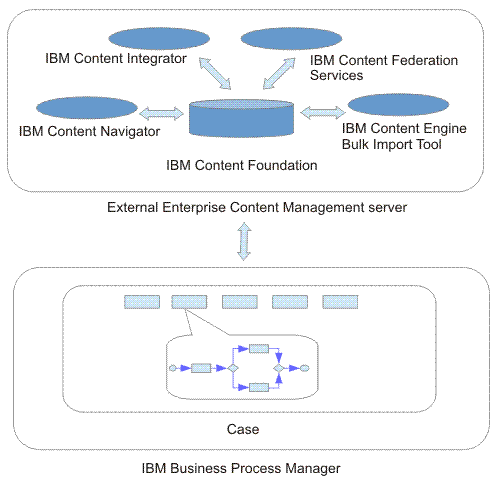Planning for an external Enterprise Content Management server
You can configure IBM® Business Process Manager with an external Enterprise Content Management (ECM) server.
IBM BPM contains the IBM BPM document store as a content repository that is used for IBM BPM documents. It is also used for case folders and its documents if you have IBM BPM Advanced with the Basic Case Management feature installed. This internal IBM BPM document store is automatically configured. Its usage is restricted so that it cannot be integrated with all existing IBM Content Foundation products.
Alternatively, you can use an external IBM FileNet® Content Manager as the content repository for the IBM BPM document store. With this approach, you can build integrated solutions that use IBM Content Foundation products. For example, you can use Content Navigator as a content-centric user interface or IBM Datacap to capture documents that come from your customers. Capturing these documents can automatically start a case. For more information, see IBM Content Foundation.

- IBM BPM documents can be accessed with JavaScript, web services, and REST APIs.
- Content integration steps can be used as in the predefined IBM BPM document store server definition. Content integration steps can also be used as in the IBM BPM content store server definition, if you have IBM BPM Advanced with the Basic Case Management feature installed.
- Coach views from the Content Management toolkit can be used with one of the predefined server definitions without any difference for either the internal or external content repository.
To use an external FileNet Content Manager installation as a content repository for the IBM BPM document store, you must have a common user repository. The repository must contain the users that work with your applications. This repository is an enterprise-wide Lightweight Directory Access Protocol (LDAP) repository that contains all the users and groups. The version of FileNet Content Manager must be 5.2.1 or higher. The FileNet Content Manager must be set up on a WebSphere Application Server.
- You can configure your IBM BPM deployment environment to use an
empty object store in an external FileNet Content
Manager installation.
This configuration is useful if you set up a new IBM BPM deployment
environment. If you already have an existing IBM BPM deployment environment,
you can use this option only if the internal content repository is
empty; otherwise, you would lose your data. For information on how
to configure this option, see Using a new object store.
- How is the existing data handled? There is no existing data.
- Where is the ECM database located? On the external FileNet Content Manager.
- Are there constraints when you use the user registry? All users and groups that are referenced by the object store must be defined in a shared user registry to work with IBM BPM and the FileNet Content Manager installation. The LDAP repository on FileNet Content Platform Engine can be either connected directly or by using Federated Repositories (VMM). Your applications that use content function must use only users and groups from the shared user registry. Non-shared users or groups, for example, from an internal file repository, are not able to work with the content. The EmbeddedECMTechnicalUser authentication alias, which is used by IBM BPM to access the external ECM with administrator privileges, must refer to a user from the shared user repository.
- You can reassign the object store of the internal content repository
to the domain of an existing FileNet Content
Manager installation.
This configuration keeps your data that exists in the internal content
repository. For information on how to configure this option, see Reassigning the IBM BPM content store.
- How is the existing data handled? You can continue to use the existing data.
- Where is the ECM database located? On IBM BPM. Since there is no data movement, the physical location of the content is still in the database of the internal content repository. This database is the database that you used for the IBM BPM document store when the IBM BPM deployment environment was set up.
- Are there constraints when you use the user registry? The constraints are similar to the previous option. However, you must use a Federated Repository (VMM) and you cannot have a direct connection to an LDAP repository. A shared user repository must be used. All users and groups that use the external FileNet Content Manager must be in the shared user repository.
- You can reassign the domain and object store of the internal content
repository to a new external FileNet Content
Manager installation.
This configuration keeps your data that exists in the internal content
repository. This configuration is useful when you set up a new FileNet Content
Manager installation.
For information on how to configure this option, see Configuring IBM BPM with a new external ECM server.
- How is the existing data handled? You can continue to use the existing data.
- Where is the ECM database located? On IBM BPM. Since there is no data movement, the physical location of the content is still in the database of the internal content repository. This database is the database that you used for the IBM BPM document store when the IBM BPM deployment environment was set up.
- Are there constraints when you use the user registry? The constraints are similar to the first option. However, you must use a Federated Repository (VMM) and you cannot have a direct connection to an LDAP repository. A shared user repository must be used. All users and groups that use the external FileNet Content Manager must be in the shared user repository.